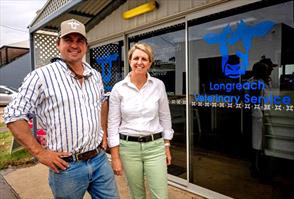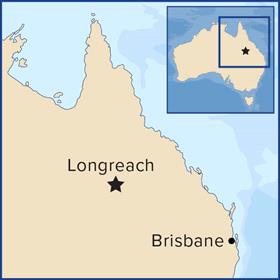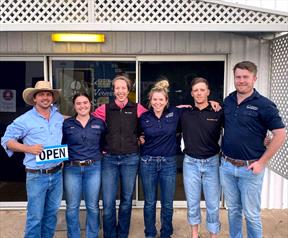 Listen to this story.
Listen to this story.
James and Manny Walker

Courtesy of Longreach Veterinary Service
James Walker, a farmer, and his wife Manny Walker, a former school teacher, are running the only veterinary practice in the Australian country town of Longreach.
Veterinarians long have had a close-knit relationship with farmers, whether they're treating their livestock, offering advice on animal husbandry or just being a friend to talk to when times are tough. But one farming family deep in the Australian outback has taken the relationship to the next level: They bought the local veterinary practice.
James Walker, a fourth-generation cattle rancher, and his wife Manny Walker, a former school teacher, assumed ownership of the only practice in the remote town of Longreach in the northeastern state of Queensland when they purchased it from a veterinarian, Dr. Toby Wass, in 2021.
"He'd just had enough," James Walker said. "I was playing cricket with him, and he said, ‘You should buy my vet clinic.' "
Wass said he decided to sell because tending to his other veterinary service — treating beef cattle for corporate clients in northern Australia — and having a growing family that lived more than 700 miles from Longreach was "was making it very difficult to juggle both businesses."
Over the ensuing two-and-a-half years, the Walkers have grown the business to a three-doctor practice, managed by Manny, and have plans to expand it into another town.
Although large agribusinesses sometimes employ veterinarians in-house to look after their livestock, it's unusual for farmers to buy clinics that serve local communities.
Indeed, the Walkers' purchase caused a buzz Down Under: It was reported in local newspapers and on television by the Australian Broadcasting Corp.
VIN News couldn't find other examples of farmers making such an unconventional move in Australia, the United States or anywhere else.
Still, many veterinarians in rural communities could be contemplating novel succession strategies, as a well-documented shortage of practitioners willing to work in remote locations puts their businesses under strain.
Walker said he was reluctant to intervene at first, not least because he isn't a veterinarian, and had no experience running a veterinary enterprise. But after taking a closer look at the practice's books he realized that — with help from friends, including in the veterinary community — he might be able to lure practitioners to Longreach and make it work.
The practice certainly isn't short of clients.
Longreach, more than 700 miles by road from state capital Brisbane, has a population of only around 3,000 people. But it's a major hub for central Queensland's cattle and wool industries.
What's more, Longreach's mixed animal clinic serves a geographic area hundreds of square miles in size: The closest other clinics are in the towns of Hughenden and Emerald, some 243 miles to the north and 258 miles to the east, by road, respectively.
"They're at least about a four-hour drive from Longreach," said Dr. Carole Lansdowne, a relief veterinarian based near Emerald who provided guidance and support to Walker while he was buying the practice. "So it's highly important that James keeps this one going."
Finding staff among myriad challenges
Although he hails from a long line of cattle farmers, Walker has diverse business interests. Apart from owning a 20,000-acre organic beef farm near Longreach, the Walkers also offer a stud service for the cattle industry, have a large-scale solar farm on their property and own a software startup that helps farmers manage their finances.
Diversifying came partly out of necessity. Rainfall patterns in and around Longreach are some of the most variable in Australia, making for unpredictable growth in pasture for grazing.
Success running those businesses helped Walker convince his bank manager to lend him money to buy the veterinary practice. He also put himself through a practice-ownership training course on Queensland's Gold Coast run by another veterinarian friend, Dr. Sam Bowden. His classmates mostly were veterinarians, who, Walker discovered, weren't especially gung-ho about embarking on a management role.
"All the vets there were going ‘Mate, why are you doing this? We hate this but we're vets.' And I said, ‘Oh no, I think that might be an advantage that I'm not a vet because I can't get distracted by the veterinary work.' "
Crucially, Walker also had to show his bank manager that he was serious about recruitment. It was quickly decided that while Manny would manage the day-to-day operations of the practice, he would devote his efforts to headhunting.
Chart_Australia_Longreach

"I made 20 phone calls a morning when we first started," Walker said. "We had an existing locum who only had four days left but I convinced her to stay another 10 days to buy me a bit more time. And she's phoned all her network, and that's how we started building it."
To attract practitioners, Walker said, he is paying above-average compensation of at least AU$200,000 (US$129,000) a year. Veterinarians in Australia earn a median full-time salary of around AU$83,000 (US$53,000), according to the Australian Bureau of Statistics, though that data was collected in 2021, and pay can vary substantially depending on skills and experience.
Walker also received guidance from Dr. Bridget Newman, who had bought a practice near the Queensland town of Rockhampton, some 426 miles away, with her businessman husband, Ross, in 2019.
"My husband knows James because they once did an entrepreneur course together," Newman said. "When we heard that he was buying the Longreach clinic, we went out there to help because we know what it's like taking over a practice."
Newman still provides assistance to the Walkers, including by visiting Longreach every six months or so — staying for a week or two each time — to help treat patients, provide advice on back-office functions like finances and logistics, or train the practice's veterinarians and veterinary nurses. Conversely, veterinary nurses in Longreach sometimes travel out to Newman's practice near Rockhampton to receive training there.
The Longreach practice's principal veterinarian, Dr. Edith Gregory, declined to be interviewed for this story. According to the practice's Facebook page, she officially stepped into the role only last month. Her husband, Dr. Lachlan Woods, has since joined as another permanent employee.
Walker said the practice currently has three permanent veterinarians, and occasionally brings in a locum. He wants to grow the team to include five permanent veterinarians.
"The bank likes us and has supported us to buy another site two hours away in Blackall," Walker said. He also has plans to open an equine reproduction center at the Longreach practice.
The start of a trend?
Longreach crew

Courtesy of Longreach Veterinary Service
Walker stands outside the Longreach practice with some of its crew. From left to right: Walker, head veterinary nurse Emily Dicinoski, Dr. Elise Kinsey, veterinary nurse Belle Williams, Dr. Max Woods and Dr. Kerry Lansdowne.
Might the Walkers' move inspire other farmers to get into the veterinary business?
The arrangement makes sense, at least in some ways, James Walker maintains, because farmers also work closely with animals and are familiar with the nature of veterinary work. "We just don't know the technical aspect of it and can leave that to the vets," he said.
Owning a practice could provide obvious benefits to a farming enterprise, such as an in-house source of care and expert advice on things like nutrition, reproduction and preventive medicine, ultimately bolstering farm productivity.
Still, Walker, a recipient of a Nuffield Farming Scholarship who has completed agribusiness courses as far afield as Texas, doubts that any old farmer could easily make the transition.
"When you go from running animals to running people, it's a whole different ball game," he said.
Newman concurs that Walker's business acumen offers him an edge that not all farmers necessarily possess. She knows from running her own practice, though, that veterinarians and businesspeople can make a formidable team.
"I think our business is successful because my husband's a businessman who runs it like a business, which then frees me up to do the veterinary work," she said. "So knowing that James was going to run this as a business really excited us because I think that's how independent vet surgeries are going to survive. The big corporate consolidators are successful because they run them like businesses."
She added that part of the appeal of working with Walker was that he remains grounded in his local community, even as he looks to expand.
"James is the kind of person that when you're in Longreach and you walk down the street, he knows everyone and everyone knows him," Newman said. "So he's someone who genuinely believes in his community."
Elsewhere in Queensland, community spirit supports a kindergarten and retirement village in the town of Theodore, which are owned by local townsfolk via a cooperative. However, that model isn't always successful. Theodore's pub, owned by the community for decades, recently was put up for sale after encountering financial difficulties.
Lansdowne, the relief veterinarian near Emerald, acknowledged that the Walkers have taken on a hefty challenge but trusts they'll do fine.
"It's bloody hard to run a vet clinic even when you're a vet," she said. "[James's] had some baptisms of fire and blundered along but he's just that sort of bloke. He's a tough guy, and he's managed to get some really good young vets out there. I hope he can hang on."